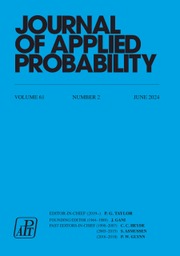No CrossRef data available.
Article contents
Duality and transform analysis for non-decreasing functionals of stochastic processes and their applications
Published online by Cambridge University Press: 30 September 2025
Abstract
We establish a novel duality relationship between continuous/discrete non-negative non-decreasing functionals of stochastic (not necessarily Markovian) processes and their right inverses, and further discuss its applications. For general Markov processes, we develop a theoretical and computational framework for the transform analysis via an operator-based approach, i.e. through the infinitesimal generators. More precisely, we characterize the joint double transforms of additive functionals of Markov processes and the terminal values in continuous/discrete time. Under the continuous-time Markov chain (CTMC) setting, we obtain single Laplace transforms for continuous/discrete additive functionals and their inverses. We apply the proposed transform methodology to computing option prices related to the occupation time of the underlying asset price process.
Information
- Type
- Original Article
- Information
- Copyright
- © The Author(s), 2025. Published by Cambridge University Press on behalf of Applied Probability Trust


